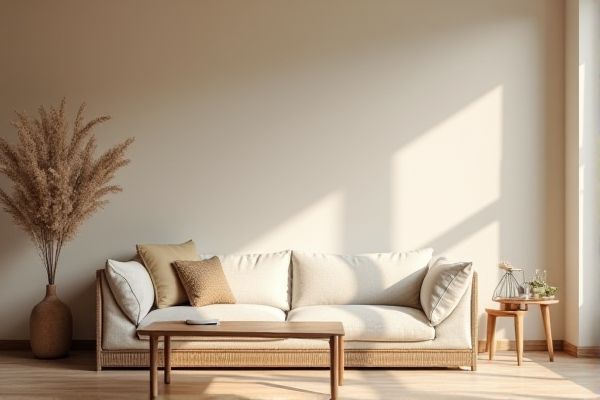
Choosing wallpaper offers intricate patterns and textures that paint often cannot replicate, providing a durable and decorative finish ideal for accent walls or complete room transformations. Your decision between wallpaper and paint affects not only aesthetics but also installation time, maintenance, and long-term costs--explore the full article to discover which option suits your space best.
Table of Comparison
| Feature | Wallpaper | Paint |
|---|---|---|
| Durability | Lasts 10-15 years; resistant to minor damage | Lasts 5-7 years; prone to chipping and fading |
| Cost | Higher initial cost; includes installation | Lower initial cost; DIY-friendly |
| Design Options | Variety of patterns, textures, and colors | Wide range of solid colors and finishes |
| Installation | Requires professional skills; time-consuming | Simple application; suitable for DIY |
| Maintenance | Easy to clean; some types moisture-resistant | May require frequent touch-ups; less moisture-resistant |
| Removal | Can be difficult; may damage walls | Simple repainting process |
| Environmental Impact | Often contains vinyl; less eco-friendly options available | Water-based paints available; eco-friendlier options |
Introduction to Wallpaper and Paint
Wallpaper offers a versatile way to add texture, patterns, and vibrant designs to walls, making it ideal for creating feature walls and enhancing room aesthetics. Paint provides a cost-effective and flexible option with a wide range of colors and finishes, allowing for quick updates and easy maintenance. Both wallpaper and paint serve as fundamental choices for interior wall decoration, each with unique benefits suited to different design preferences and project scopes.
Aesthetic Differences: Wallpaper vs Paint
Wallpaper offers intricate patterns, textures, and designs that create a bold visual impact, while paint provides a smooth, uniform finish ideal for minimalist or customizable color schemes. Wallpaper can add depth and dimension to a room with its variety of materials like vinyl or fabric, whereas paint allows for easy color changes and quick refreshes to suit evolving aesthetic preferences. Your choice depends on whether you prioritize unique, detailed wall decor or versatile, straightforward surface enhancements.
Cost Comparison: Which Is More Affordable?
Wallpaper generally involves higher upfront costs due to material prices and professional installation fees, while paint tends to be more budget-friendly with lower material and labor expenses. Paint offers greater flexibility for changes and touch-ups, reducing long-term costs compared to wallpaper, which may require entire panel replacements. Considering your budget and the room's specific needs can help determine whether wallpaper or paint provides a more affordable option.
Durability and Maintenance
Wallpaper offers superior durability compared to paint, with many types lasting up to 15 years without fading or peeling, ideal for high-traffic areas. Paint requires regular touch-ups every 3 to 5 years due to its susceptibility to scratches, stains, and moisture damage. Your choice should consider the ease of maintenance; wallpaper often needs gentle cleaning with a damp cloth, whereas painted walls allow for more frequent scrubbing and repainting.
Installation Process: Ease and Time
Wallpaper installation demands precise surface preparation and careful alignment, often taking several hours or even days depending on wall size and pattern complexity. In contrast, painting generally requires less surface prep and can be completed more quickly, especially with modern rollers and spray tools. Your choice between wallpaper and paint affects both the installation ease and the overall project timeline significantly.
Variety and Customization Options
Wallpaper offers an extensive variety of patterns, textures, and colors, allowing intricate designs and unique finishes that paint cannot easily replicate. Paint provides broad customization through countless shades and finishes, enabling seamless color blending and tailored wall effects. Combining both materials enhances aesthetic flexibility, catering to personalized interior design preferences.
Eco-Friendliness and Health Impacts
Wallpaper often contains VOCs (volatile organic compounds) and synthetic adhesives that can negatively impact indoor air quality, whereas many modern paints offer low-VOC or zero-VOC options, making them more eco-friendly and safer for your health. Natural or washable wallpapers made from sustainable materials can reduce environmental harm but may still release allergens or irritants during installation and removal. Choosing low-VOC paint or eco-certified wallpaper helps minimize health risks and supports a greener home environment.
Suitability for Different Room Types
Wallpaper offers a wide range of designs and textures suited for accent walls, living rooms, and bedrooms where visual impact is desired, while paint provides versatile and easy-to-maintain options ideal for kitchens, bathrooms, and high-traffic areas prone to moisture and wear. Your choice depends on the room's function and environmental conditions, as wallpaper may struggle with humidity, whereas paint can resist moisture and is simple to refresh. Consider using wallpaper in low-moisture spaces and opting for durable, washable paint finishes in rooms requiring frequent cleaning.
Removing and Replacing: Wallpaper vs Paint
Removing wallpaper is often more time-consuming and labor-intensive than stripping paint, typically requiring soaking, scraping, and sometimes chemical solvents to avoid damaging walls. Paint removal usually involves simpler sanding or recoating processes, making repainting faster and less cumbersome. Replacing wallpaper demands precise alignment and matching, while repainting allows for easier touch-ups and color changes, offering more flexibility for updates.
Final Verdict: Choosing the Right Wall Finish
When deciding between wallpaper and paint, consider durability and style preferences to find the best fit for your space; wallpaper offers intricate patterns and textured finishes that paint cannot replicate, while paint provides easier application and quicker updates. Your choice should reflect the room's function, with wallpaper ideal for accent walls and high-traffic areas requiring added protection. Ultimately, selecting the right wall finish balances aesthetic appeal with practicality, ensuring lasting satisfaction in your interior design.
 homyna.com
homyna.com